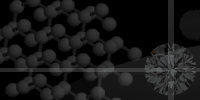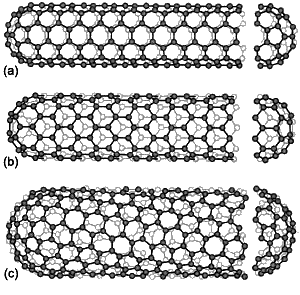


|
Nanotubes The discovery in 1985 of buckminsterfullerene opened a new era for the chemistry of carbon and for novel materials. The Japanese Sumi Ijima discovered nanotubes in 1991. The nanotubes synthesised in the laboratory showed remarkable mechanic properties as well as thermal conductivity and resistance to flame. These nanotubes consist of layers of graphite in the form of cylinders and often closed at both ends. They can exist as single and multi walled nanotubes. Normally their diameter is only a few nanometres and their length a millimetre (figure 8).
Figure 8. Nanotubes (a) armchair (b) zig zag (c) chiral Nanotubes can be obtained by mixing the soot of nanotubes of carbon in water and surfactant. This viscous solution is rotated in a substance capable of aggregating the nanotubes. A liquid is then injected to aid the formation of a rectangular section, which rolls itself into a cylinder and thus forms carbon nanotubes. Another method is to decompose methane with a catalyst. The enlargement of the basal plans of graphite on existing surfaces causes nanotubes without extremities to extend and l’epaissement the tubes. These tubes are semi-conductors or metallic conductors depending on small variations of their angle of curvature or diameter. This angle defines the type of nanotube (armchair, zig zag or chiral) and it is determined by the way the layers of graphite wrap around and interact with themselves. Their properties of conduction depend on their diameter and the way they are helicoidal. Nanotubes are tested with scanning tunnelling microscopy at low temperatures, and a measure of their electronic and physical structure. Even with nanotubes made by different methods, the results are complimentary and confirm that the conduction is only in one dimension. Nanotubes could become the new carbon fibres. At the moment the strings for tennis racquets are graphite fibres with a microscopic structure of honeycombs. If these fibres were made with nanotubes, the strings would be much stronger and resistant because nanotubes have the same honeycomb structure but the layers are rolled into cylinders so they must be stronger and superior to graphite strings! Actually nanotubes are the most resistant fibres known. A sole nanotube is about 10 to 100 times more resistant and six times more light than steel by mass unity. Their applications are therefore immense, concerning many domains from medicine to construction. Nanotubes are very good conductors and they are deformable under electronic force.
Home ||
Diamond ||
Graphite ||
Buckyballs ||
Nanotubes ||
Fullerenes
Samantha Shanley, School of Chemistry, University of Bristol |

